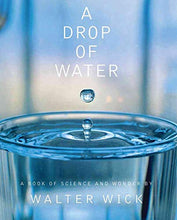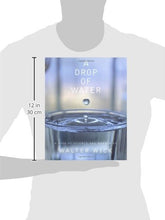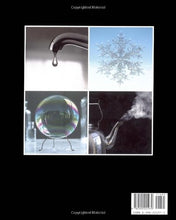A Drop Of Water: A Book of Science and Wonder
The most spectacular photographs ever created on the subject of water appear in this unique science book by Walter Wick.
The camera stops the action and magnifies it so that all the amazing states of water can be observed water as ice, rainbow, steam, frost, dew.
Readers can examine a drop of water as it falls from a faucet, see a drop of water as it splashes on a hard surface, count the points of an actual snowflake, and contemplate how drops of water form clouds. Evaporation, condensation, capillary, attraction, and surface tension are explained through simple text and illustrated by pictures that reveal water in its many awesome transformations. The last pages of the book feature experiments that welcome the reader into the world of scientific investigation.
In A Drop of Water, Walter Wick embraces two disciplines, art and science, and stimulates the reader as aesthetic and scientific observer. Amazon.com Review The curious, protean nature of water has fascinated people for ages, and Walter Wick--the photographer of Scholastic's highly acclaimed I Spy series--is no exception.
Wick is a great admirer and collector of 100-year-old science books where, according to his afterword, "Even the simplest experiments appeared as if improbable or impossible things were happening. Intrigued, I recreated some of the experiments and photographed them with my camera. The results seemed magical, but not because of any photographic trick; it was only the forces of nature at work. It was from these explorations that the idea for this book emerged." As you're admiring the "crown" created by a water drop splashing into a pool, or how many water droplets can fit on the head of a pin (the smallest droplet on the pin contains more than three trillion water molecules), you'll learn about evaporation, condensation, snowflakes, how clouds form, and more amazing water tricks.
Wick's other artfully composed photographs include a "wild wave" caused by a brown egg dropped in a water glass, soap bubbles with a "shimmering liquid skin," a snowflake at 60 times its actual size, and dew on a spider web. Like many old-fashioned science books, A Drop of Water ends with a list of simple experiments may lure the young reader into the world of scientific investigation. Unlike many old science books, this one also stands on its own as a beautiful, notable collection of photographs.
From School Library Journal Grade 3-6. Wick's striking color photographs of water in various states and stages of movement capture moments of change in beautiful patterns that cannot be observed without the advantages of stop action and magnification. These pictures present water drops; soap bubbles; water condensing and evaporating; snowflakes, frost, and dew; and water as a prism. The paragraphs of text that accompany the images read like extended captions; they describe what is being pictured and briefly comment on the phenomenon taking place. A set of short directions for doing the observations and experiments included appears at the end.
The photographs are the outstanding feature here; they do stimulate wonder. Perhaps the book succeeds more as an exploration of their use to enhance scientific observation than as a description of the characteristics of water. Wick clearly shows that science and art both offer ways to observe the world around us. However, the visuals may stimulate a level of curiosity that will not be satisfied by the brief text?something that makes the lack of a list for further reading a drawback.?
Carolyn Angus, The Claremont Graduate School, Copyright 1997 Reed Business Information, Inc. From Booklist Gr. 3^-6, younger with adult help. Science books with beautiful full-color photographs are not uncommon, but often the pictures are gathered from many different sources. Consequently, the photos rarely illustrate the text with the unity, precision, and elegant simplicity found in this book about the nature of water.






